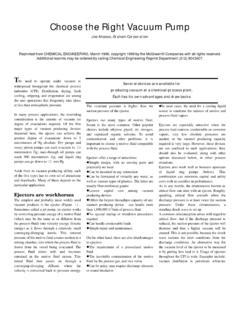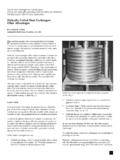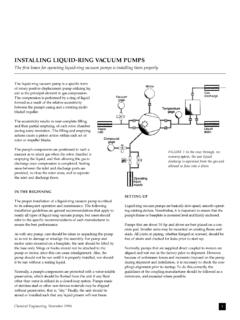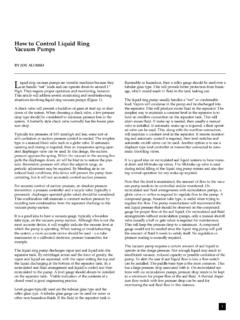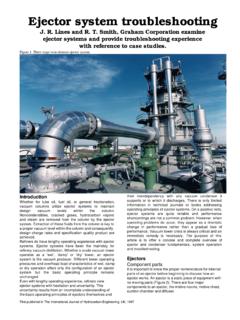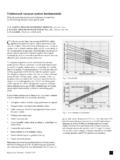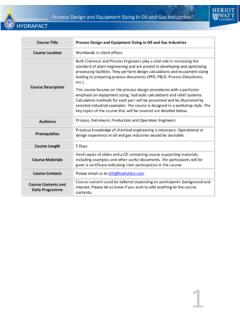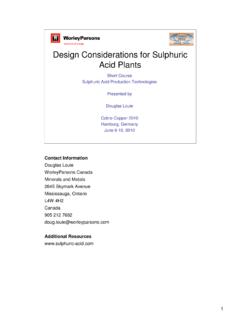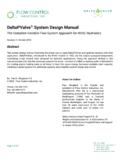Transcription of Specifying Steam Surface Condensers - Graham …
1 THE FORMULA for determining theamount of Surface required in a surfacecondenser is as follows:Q = UA (LMTD) (1)whereQ = Heat to be absorbed, Btuh =pounds per hour of Steam times 950 Btu per pound;U = Overall heat transfer rate, Btu per(hr) (sq ft) (F);A = Surface required, sq ft;LMTD = Loge mean temperaturedifference between condensingtemperature and cooling attempt will be made to go througha formal condenser selection. Theprocedure for condenser rating isamply covered in the publication ofHeat Exchange Institute entitled,"Standards for Steam SurfaceCondensers."* Rather we shall attemptto discuss qualitatively the factorsaffecting selections and their effectson size and Steam RateTurbine Steam rate is usuallyexpressed in pounds per hour ofsteam per brake horsepower and iscommonly called the water rate.
2 Thiswater rate is a function of motive steampressure and temperature, condensingtemperature, or equivalent vacuum,and turbine efficiency. Specificinformation for a given turbineapplication can be obtained_____This Standard is currently out of print, but anew edition is in preparation and will beavailable in the future from Heat ExchangeInstitute, 122 E. 42nd St., 'New York, the turbine speaking, on systems wherethe motive Steam pressure isapproximately 150 lb and the turbine isdischarging to a vacuum of mercury (4 in. Hg absolute) , a steamrate of 14-16 lb per hr per bhp iseconomically feasible. Althoughgreater efficiency is available atincreased cost, utility costs for thistype of installation seldom justifyreducing the Steam consumption bymeans of higher ef-ficiency turbines orlower condensing pressures.
3 Whenspecial conditions are present, thespecifying engineer may considereither of the above modifications toimprove VacuumThe vacuum produced in a steamcondenser is that pressurecorresponding to the temperature atwhich the Steam condenses. Thissteam condensing temperature, in turn,is dependent upon the temperature ofcooling water entering the condenserand the quantity of water Steam condensing temperaturecan get down to as low as 5F abovethe entering cooling water temperature,but in most air conditioninginstallations the differential is 20F,sometimes 10F, but seldom smaller, asthe closer approach would require acostly amount of condenser practice, cooling tower water is firstused in the refrigerant condenser,where it rises about 10F and is thenavailable for Steam condensing.
4 Thegreat bulk of Steam -driven cen-trifugalrefrigeration systems operate with asteam condenser vacuum ofapproximately 4 in. Hg abs., which isequivalent to a condensingtemperature of Thus, referringto Fig 1 and presuming that 85 Fcooling water is supplied to the systemfrom the cooling towers, watertemperature into the Steam condenseris approximately 95F. Assuming aturbine Steam rate of 14-16 lb per hr perbhp (bhp per ton of refrigeration isapproximately 1) and a condensingwater circulation rate of 3 gpm per tonof refrigeration, water rise on the steamcondenser is also about 10F. Thus, theleaving water temperature approach is20F(125F minus 105F).by Elliot SpencerGraham , Inc., Great Neck, Long Island, affecting condenser design and typical air conditioning Surface condenser specification is SteamSpecifying SteamSurface CondensersSurface CondensersIf, on the other hand, we designed thesteam condenser for 3 in.
5 Hg. abs.,which is equivalent to a condensingtemperature of 115F for the sameapproximate water temperature rise, theapproach would be 10F (115F minus105F). Thus from Eq (1), because thelog mean temperature difference isgreater, we see that the condenserdesigned for 4 in. Hg abs. requires lesssurface than the one designed for 3 inHg foregoing example is anoversimplification. In practice, thesteam rate of a turbine discharging at 4in. Hg. abs. is somewhat higher thanone discharging at 3 in. Hg. of a lower absolute pressuremight permit using a turbine with oneless wheel, which would result inreduced turbine cost. This reducedturbine cost might or might not beoffset by the increased condensercost. (See "Is There a Steam Turbine inYour Future," ACHV, April, 1968, pp43-47.)
6 Similarly, condenser cost couldbe reduced if the condenser wereoperated at 5 in. Hg. abs. ( ). However, turbine costmight increase more rapidly if thesteam rate had to be held to apreviously set value, which, asindicated, is generally in the range of14-16 lb per hr per , the specification should simplystate the number of pounds per hourof Steam to be used and the maximumtemperature and quantity of availablecooling water, omitting the preciseoperating vacuum to be maintained bythe Surface condenser. This permitsthe manufacturer to offer the bestcombination of condenser, turbine andrefrigeration unit to comply with thelimitations on Steam considerations, such as lengthlimitations and turbine vapor exhaustsize, very often have a determiningaffect on condenser TemperatureAs cooling water temperaturedetermines the vacuum that can beproduced, it is imperative that themaximum anticipated water temperaturebe specified.
7 This temperature isdetermined by the water source andvaries with the location of theinstallation. Water flow rate to thecondenser is usually determined bythe refrigeration manufacturer and isgenerally set at approximately 3 gpmper ton of refrigeration when coolingtowers are used. However, when riverwater or water at relatively lowtemperature is available, water flowrate varies and specifications shouldtake these variations into recent trend in large multi-storyoffice buildings has been to use 2 gpmper ton of refrigeration. Although thisaffects condenser, and turbineadversely due to higher condensingtemperatures, there is a saving incondenser water often, specifications state that thesurface condenser shall be capable ofhandling turbine exhaust whilemaintaining the desired vacuum with a5% increase in normal Steam with this requirement isalmost impossible.
8 Specificationsseldom provide the 5% greater waterquantity needed to balance this 5%loading factor. Further, usually noprovision is made for the extra load onthe cooling tower and the change insteam rate of the turbine whenoverload hand valves are , the refrigeration machineis operating at a different point on itscurve and may be rejecting more heatwhich, in turn, means hotter water tothe Steam condenser. The net resultunder the 5% excess load condition isthat the Steam condenser receivescooling water that is more than 5%above the initial design temperatureand the resulting excess heat impartedto the water overloads the coolingtower, further aggravating it has been decided that the surfacecondenser should have additionalsurface in it, the most practicalapproach would be to state that theunit shall have 5% excess Surface or10% or whatever is needed.
9 In general,a Surface condenser will handle theentire excess load at a slight increasein back pressure. If this is permissible(and it must happen unless allaccessory items have built-in excesscapacity), no statement of excesscapacity need be Pressure DropWater side pressure drop is a functionof tube velocity, condenser length andthe number of passes the water has tomake in a given condenser. Airconditioning practice permitsvelocities as high as 10 fps in the tubeside of refrigerant Condensers and, inrecent years, this has been extended toapply to Steam Surface Condensers forair conditioning has been common practice to limitwater pressure drop to 10 ft. However,if this limitation is rigidly enforced,velocities must be reduced to complywith this pressure drop requirement,resulting in lower heat transfer ratesand higher condenser costs.
10 Generally,water pressure drops of approximately15 ft can be attained in most single-pass Condensers operating at 4 in. Hgabs. Most two-pass Condensers ,usually those running at 3 in. Hg abs.,require pressure drops as high as of water velocity andmaterials of construction for tubes andtube sheets where river water orbrackish water is involved must becarefully evaluated. Informationshould be obtained on the experienceof other users in the area havingsimilar design conditions before aspecific material is selected. Generallyspeaking, for brackish waterapplications, velocities in excess of can seriously reduce tube life, butfor cooling tower applications a 10 fpsvelocity is FactorMost Surface Condensers for airconditioning and power plantapplications are designed with acleanliness factor of 85%.

